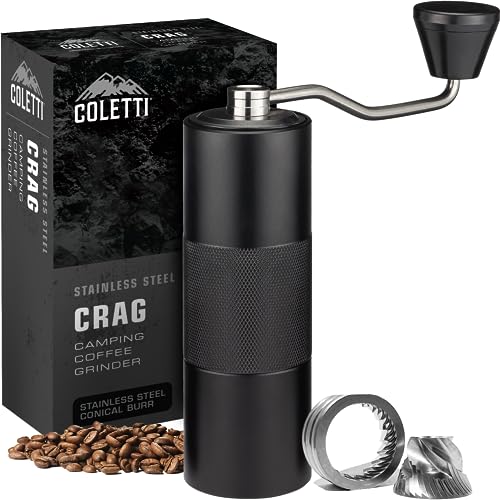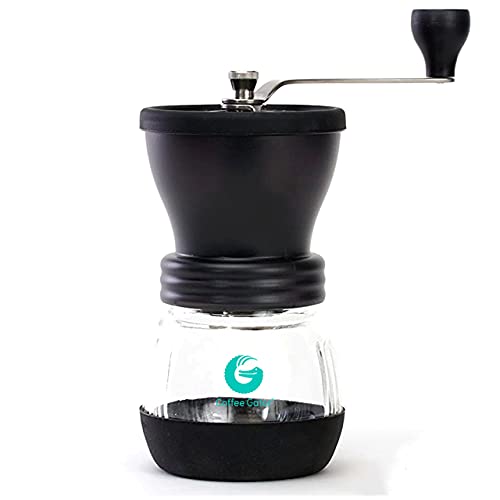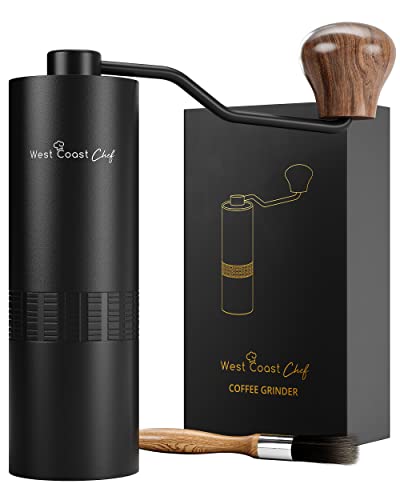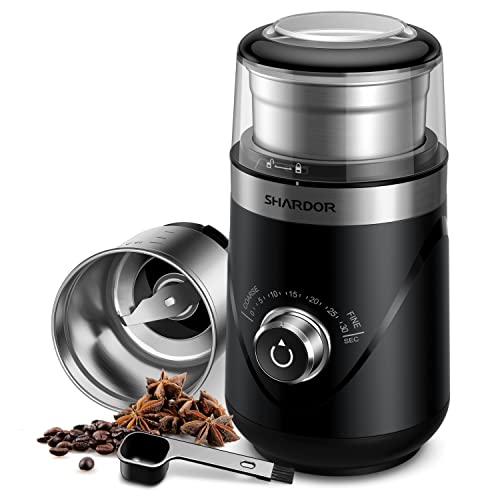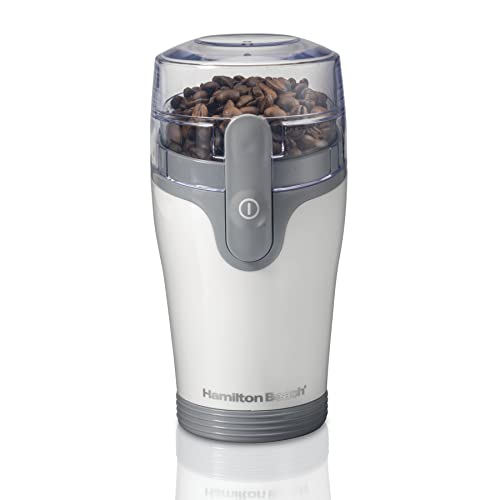- sign in
- Design
- Food
- Pop Culture
- Style
- DIY Classes
The Best Coffee Grinder of 2024
Our top picks that make every cup worth drinking.
E-Commerce WriterPublished on January 12, 2024Last updated on May 8, 2024Waking up to the aroma of freshly ground coffee beans is a luxurious feeling that is reserved for coffee connoisseurs. Coffee grinders allow coffee lovers to indulge in the joy of grinding their own beans, transforming them into a rich, flavorful brew. A coffee grinder's importance lies in its ability to extract the hidden potential within a coffee bean, releasing aromatic oils and preserving the bean's freshness. The best coffee grinder from COLETTI gives you a consistent grind every time. In this article, we will explore the best models and guide you to select the perfect grinder that can elevate the humble coffee bean to a caffeinated masterpiece.
The COLETTI Crag Hand Coffee Grinder is an excellent choice for those who truly appreciate a fresh, perfectly ground cup of coffee every day. This manual coffee grinder stands out for its CNC techno...
read moreImportant Features- Handheld manual coffee grinder
- Adjustable grind settings
- Stainless steel construction
- Portable and travel-friendly design
The Coffee Gator Hand Coffee Grinder is a top-notch product suited for passionate coffee enthusiasts, especially those who prefer brewing their own cup. Simplicity is key to this grinder, proving it...
read moreImportant Features- Manual control for coarseness level
- Multiple grind setting options
- Durable stainless steel construction
- Compact and travel-friendly design
The West Coast Chef Manual Coffee Grinder is a game-changer for coffee lovers who prefer a consistent grind size for their beans. This manual burr grinder is not just a tool, but a more intimate cof...
read moreImportant Features- Precision adjustment dial
- Detachable handle
- Compact design
- Includes cleaning brush
The SHARDOR Adjustable Electric Coffee Grinder is a quiet, ergonomically designed coffee-making companion that aims to make every morning more enjoyable. This coffee grinder is perfect for anyone wh...
read moreImportant Features- Adjustable grind precision with timing marks
- Includes removable 2.5-ounce grinding cup
- Automatic stop feature after grinding
- Comes with a spoon for powder dispensing
The Hamilton Beach Electric Coffee Grinder is a versatile appliance that is focused on consistent grinding performance. It stands out for its flexibility, being able to grind not only coffee beans b...
read moreImportant Features- Dishwasher-safe removable grinding bowl
- One-button operation design
- Stainless steel grinding blades
- Features a stainless steel base
Best Coffee Grinders
Best OverallCOLETTI Crag Hand Coffee Grinder
The COLETTI Crag Hand Coffee Grinder is an excellent choice for those who truly appreciate a fresh, perfectly ground cup of coffee every day. This manual coffee grinder stands out for its CNC technology, promising consistent grind size at every turn. Whether you enjoy a robust French press or a delicate espresso, this device ensures that you get the optimal extraction and flavor from your coffee beans. The uniform grind size also means you won’t have to deal with unpredictable bitter or sour shots that can ruin your coffee experience.
Fabulously functional and compact, this coffee grinder is not just perfect for home use, but its travel-friendly design also makes it an essential companion for camping, hiking, and other adventures. This device delivers a great grind without the need for electricity or batteries, making it very convenient for outdoor enthusiasts. The durable construction of this hand grinder ensures long-term use, providing value for your money.
Pros- Provides a consistent grind every time
- Easy to use and clean
- Ideal for home and travel use
Cons- Grind level setting is unclear
Best Portable OptionCoffee Gator Hand Coffee Grinder
The Coffee Gator Hand Coffee Grinder is a top-notch product suited for passionate coffee enthusiasts, especially those who prefer brewing their own cup. Simplicity is key to this grinder, proving it to be remarkably easy to use. The coffee grinder comes with adjustable bean settings, letting you grind your coffee beans to your preferred texture – fine for espresso and coarse for a French press. Moreover, the hand crank operation conserves energy and adds a personal touch to your coffee brewing process.
One of the standout features of this coffee grinder is its portability. You can take it anywhere, making it perfect for those with on-the-go lifestyles or for travel adventures. Despite its compact design, this grinder does not compromise on quality. Its manual burr grinders are perfect for drip, espresso, and French press, ensuring every cup of coffee tastes fresh and delicious.
Pros- Simple to use and clean
- Adjustable grind settings
- Ideal for outdoor usage
Cons- Time-consuming grinding process
Most Efficient GrindWest Coast Chef Manual Coffee Grinder
The West Coast Chef Manual Coffee Grinder is a game-changer for coffee lovers who prefer a consistent grind size for their beans. This manual burr grinder is not just a tool, but a more intimate coffee-making experience. It allows you to manually adjust the grind size, which is perfect for those who like to tweak their coffee grinds for the ideal flavor.
This coffee grinder is best for precise grind adjustments, meaning it provides the flexibility to grind beans for either an espresso or a French press. It’s also portable and travel-friendly, ensuring you never have to compromise on the quality of your coffee, no matter where you are. It quickly grinds a pour-over cup in just 40 seconds.
Pros- Easy and adjustable grind sizes
- Durable stainless steel mechanism
- Perfectly measures coffee beans
Cons- Heavy for traveling
Quietest Coffee GrinderSHARDOR Adjustable Electric Coffee Grinder
The SHARDOR Adjustable Electric Coffee Grinder is a quiet, ergonomically designed coffee-making companion that aims to make every morning more enjoyable. This coffee grinder is perfect for anyone who enjoys freshly ground coffee but doesn’t want to disturb others in the early hours. It’s designed to generate less than 85 decibels of noise during use, making it one of the quietest coffee grinders on the market.
This coffee grinder is not just quiet but also well-designed. The product’s ergonomic design includes a removable stainless steel bowl for easy cleaning and a black, sleek body that fits well into any kitchen decor. Additionally, this coffee grinder is adjustable, allowing you to customize your grind size for the perfect cup of coffee every time. It’s also a useful tool for grinding spices.
Pros- Easy to clean removable cup
- User-friendly
- Quieter than other grinders
Cons- Inconsistent grind size
Most Budget-FriendlyHamilton Beach Electric Coffee Grinder
The Hamilton Beach Electric Coffee Grinder is a versatile appliance that is focused on consistent grinding performance. It stands out for its flexibility, being able to grind not only coffee beans but also a variety of spices, thanks to its robust stainless steel blades. The removable chamber of the coffee grinder provides convenience as it facilitates easy filling, pouring, and cleaning, given that it is safe for dishwasher use. It’s designed to grind enough coffee to brew up to 12 cups, making it ideal for both personal use and hosting guests.
Despite its numerous functionalities, the coffee grinder is budget-friendly, proving to be a value-for-money investment for all coffee lovers. Its operation is simple and user-friendly, requiring just a press and hold of one button. This coffee grinder does not sacrifice quality for cost, offering a reliable, high-performing grinding solution for all coffee enthusiasts.
Pros- Dishwasher safe
- Multiple grind settings
- Versatile for spices and coffee
Cons- Loud grinding
Choosing the Perfect Coffee Grinder: A Buyer's Guide
Coffee, is the elixir of life for many, and for some, a passionate pursuit. If you are one of the latter, you’re probably aware that to achieve the perfect cup of coffee, you need to start with the right grinder. In this step-by-step guide, we’ll explore the essential attributes to consider when buying the best coffee grinder.
Burr Type
The first thing to consider is the burr type. Here we have two types, namely flat burrs and conical burrs. Flat burrs grind coffee into even particles, which aids in extracting the flavor evenly, resulting in a balanced taste. Conical burrs, on the other hand, grind coffee into two particle sizes, adding complexity to the coffee taste. Your choice will depend on your taste preference.
Grind Size Adjustment
If you love different styles of coffee, like espresso or French press, then a grinder with an adjustable grind size is a must. Grind size adjustment allows you to control the coarseness of your coffee grounds. Espresso requires a finer grind, while French press or cold brew requires a coarser ground. The best coffee grinder will offer a wide range of grind sizes to cater to your various coffee needs.
Grind Consistency
The consistency of your coffee grounds plays a significant role in the taste of your coffee. Uneven grounds can lead to uneven extraction, resulting in a subpar taste. For a consistent taste every time, you need a grinder that can produce uniform grounds. Usually, higher-end grinders offer better consistency.
Motor Speed
Motor speed might seem insignificant, but it plays a crucial role in the quality of your coffee grounds. High-speed motors can cause the grinders to heat up, resulting in burnt coffee grounds. Conversely, a low-speed motor prevents overheating, ensuring the flavor of your coffee is preserved. It is advisable to opt for a coffee grinder with a low-speed motor.
Material Quality
Your coffee grinder’s lifespan hugely depends on the material used for the burrs. Stainless steel burrs are sharp and durable, but they tend to lose their sharpness over time. Ceramic burrs, on the other hand, stay sharp for a long time, but they can break if a small stone or a similar hard material gets into the grinder. Depending on your usage, you can choose between the two.
Noise Level
Let’s face it; nobody likes to wake up to the noise of a loud coffee grinder in the morning. While all grinders make some noise, the decibel level can vary. Burr grinders tend to be quieter than blade grinders, and manual grinders are the quietest. Decide on your noise tolerance level before buying a coffee grinder.
Cleaning and Maintenance
Last but not least, consider the cleaning and maintenance of the grinder. Coffee oils can build up in the grinder, affecting the taste over time. Some grinders come with cleaning tools and are easy to disassemble for cleaning, while others do not. Choosing a grinder with easy maintenance can save you a lot of time and effort and ensure your coffee always tastes fresh.
How I Grind My Coffee Beans
Figuring out the right grind setting is a bit of a puzzle, and no amount of YouTube tutorials seem to crack it entirely.
Let’s start with a basic truth: the grind setting hinges largely on how you brew your coffee. From the coarsest to the finest, you’ve got cold brew, French press, Chemex, auto drip machines, pour-over, espresso, and Turkish. The good news? Generally, you don’t need to fuss over adjusting the setting on your coffee grinder between batches—except maybe for espresso, but, we’ll get into that later.
Now, how did I, a once-novice, find my grind-setting groove? I tried two approaches:
The Local Coffee Shop Hack
First, I visited a local café, one where I particularly liked their coffee. I asked them to grind a small batch for my brewing method and took it home in a little bag. This hands-on comparison with my coffee grinder was enlightening. It works wonders, especially if the café brews coffee the same way you do.
The Timing Technique
Particularly useful for pour-overs. Here’s how it goes: Measure your coffee dose (about 18g for a standard 10 oz mug) and aim for a 2-3 minute pour over time. If your coffee runs through too quickly, your grind is likely too coarse. If it’s a painfully slow drip, it’s too fine. For espresso, you’re aiming for a 30-second brew time. It’s not an exact science, but it’s a great starting point.
When it comes to pour-over, it’s all about timing and adjustment. Begin a timer as you pour water and stop it once you’re done. If the brew time is too short, go for a finer grind; if it’s too long, a coarser one should do the trick. But remember, the freshness of your beans also plays a role. Fresh beans bloom more, affecting the flow rate. And don’t forget the quantity—different amounts of coffee may require adjustments in grind size to maintain the same brew time.
How To Grind Coffee Beans for Espresso
When it comes to preparing espresso, the grind of your coffee beans becomes a critical factor in pulling that perfect shot. Through my own trials and a bit of research, I’ve discovered that the key lies in using a burr grinder and achieving a consistently fine grind.
Why burr grinders reign supreme
The choice of coffee grinder can make or break your espresso. Burr grinders are the champions in this arena, far outperforming blade grinders. The reason? They deliver a much more uniform grind size, which is a non-negotiable for top-notch espresso extraction. With a blade coffee grinder, you’re more likely to end up with uneven grounds, including dreaded coarse bits that can ruin the extraction balance.
Achieving the ideal grind size
The grind size for espresso is finer than what many are used to. Think of the texture of table salt—that’s what you’re aiming for. This fine grind is essential because it creates the right resistance to the water passing through under high pressure, a fundamental aspect of espresso brewing.
Preparation is key
Once your beans are ground to that fine, salt-like consistency, the next step is just as crucial. Distributing the grinds evenly in the portafilter is a step you don’t want to skimp on. An uneven distribution can lead to channeling, where water finds the path of least resistance, resulting in an uneven extraction. To combat this, ensure that the grounds are leveled out in the portafilter before tamping.
The tamping technique
After leveling, apply a firm and even pressure while tamping. This will compact the grounds evenly, preventing water from blitzing through too quickly or too slowly. The goal here is to create a compact bed of coffee through which the water can permeate evenly, extracting all the goodness without over-extracting.
Coffee Grinder FAQs
Q: How do I use a coffee grinder?A: To use a coffee grinder, you would first load your coffee beans into the grinding chamber, then select your desired grind size. After that, you simply press the start button and wait for your beans to be ground or turn the handle to manually grind the beans.
Q: What are the different types of coffee grinders?A: There are two main types of coffee grinders: blade grinders and burr grinders. Blade grinders operate much like a blender, chopping up the beans and often resulting in an uneven grind. Burr grinders, on the other hand, crush the beans between two burrs to a uniform size.
Q: How do I clean a coffee grinder?A: Most coffee grinders can be cleaned by removing the grinding chamber and washing it by hand with warm, soapy water. Be sure to remove any leftover coffee grounds from the grinder before washing. It's also recommended to dry thoroughly before reassembling.
Q: Why is my coffee grinder not working properly?A: There could be several reasons for this. The grinder may be clogged with coffee grounds, the blades or burrs may be dull, or there may be a problem with the motor. If you've cleaned the grinder and it's still not working, it may be time to contact the manufacturer for further assistance.
Q: How often should I clean my coffee grinder?A: It's recommended to clean your coffee grinder at least once a week if you use it regularly. This will prevent coffee residue from building up and affecting the taste of your coffee.
Q: Why is the grind of my coffee inconsistent?A: This could be due to the type of grinder you're using. Blade grinders often produce an inconsistent grind. If you're using a burr grinder and still experiencing this problem, it could be due to worn out burrs or an issue with the grind setting.
Q: Can I use a coffee grinder for other purposes?A: Yes, many people use their coffee grinders to grind spices, nuts, and seeds. However, be aware that this could lead to cross-contamination of flavors.
Q: Why is my coffee tasting bitter?A: This could be due to over-extraction, which often results from coffee grounds that are too fine. Experiment with adjusting the grind size on your coffee grinder to achieve a more balanced flavor.
Q: What grind size should I use for my coffee?A: The ideal grind size depends on your brewing method. For example, a French press requires a coarse grind, while an espresso machine requires a fine grind. Refer to your coffee maker's instructions for recommended grind sizes.
We may earn a commission if you make a purchase through one of our links. The newsroom or editorial staff was not involved in the creation of this content.Rida is a freelance writer, makeup reviewer and lover of all things interior design. She has 5+ years of experience in writing and specializes in e-commerce content. Rida can fluently speak 8 different languages and make an epic Spanish latte.Related Reviews

